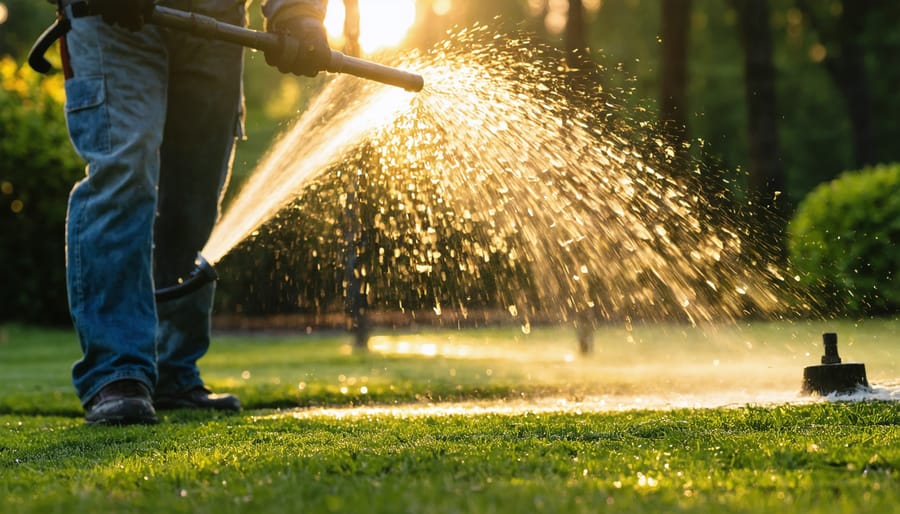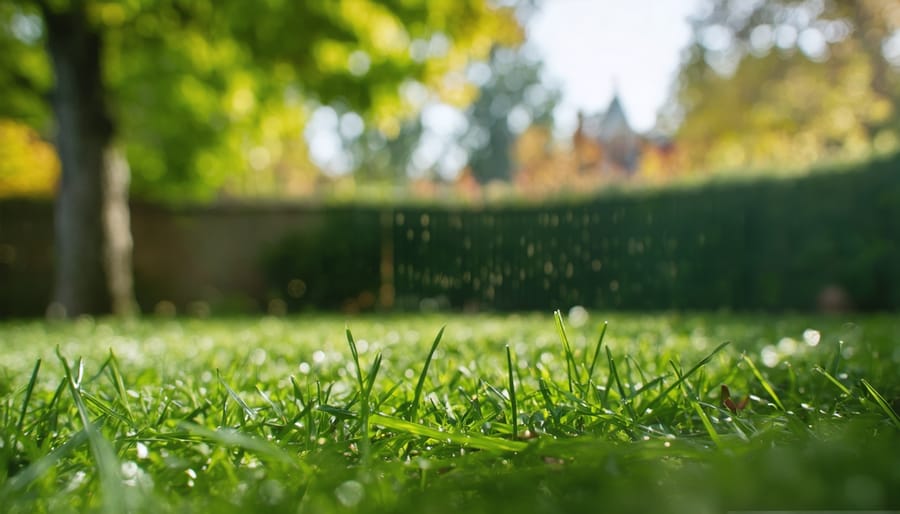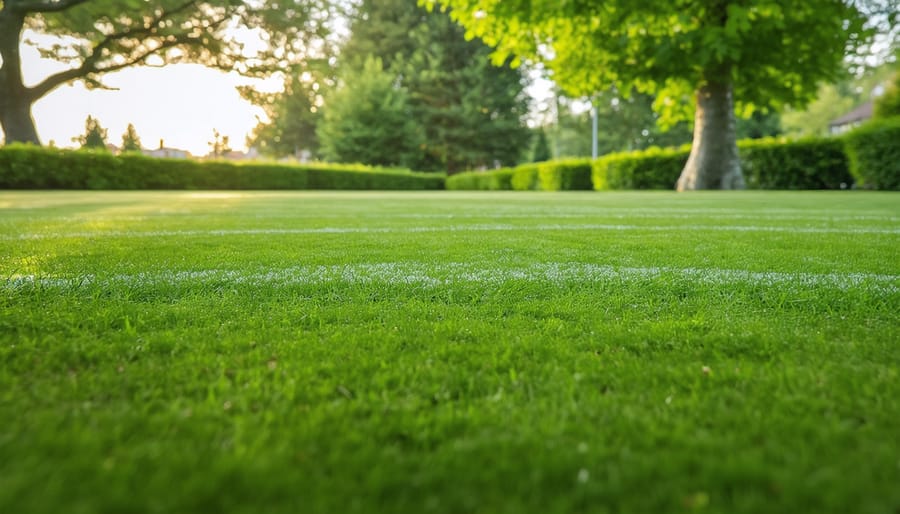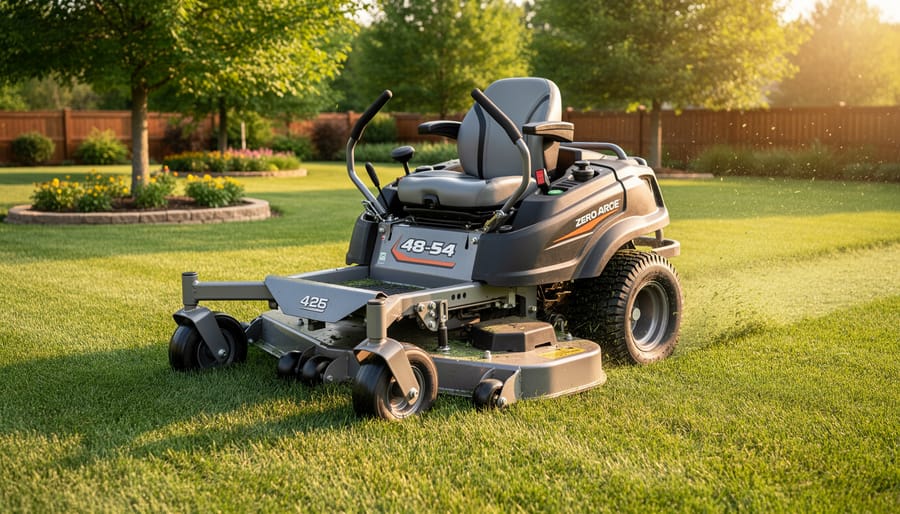Transform your lawn into a lush, healthy oasis by following a proven seasonal treatment plan. Starting with a comprehensive soil test reveals exactly which nutrients your grass needs, eliminating guesswork and preventing wasteful over-fertilization. Strategic core aeration in early spring or fall creates pathways for water, oxygen, and nutrients to penetrate deep into the root zone, while systematic overseeding strengthens thin areas and introduces drought-resistant grass varieties. Implementing precise watering schedules – delivering 1-1.5 inches of water weekly during early morning hours – establishes deep root systems that naturally resist weeds, pests, and environmental stress. Whether you’re battling stubborn crabgrass or nurturing new growth, this science-based approach to lawn care delivers professional-grade results while promoting environmental sustainability. Master these foundational techniques, and watch your lawn become the envy of the neighborhood.

Spring Wake-Up: Essential Early Season Treatments
Post-Winter Lawn Assessment
As winter’s grip loosens, it’s crucial to assess your lawn for signs of cold-weather damage. Start by walking your entire lawn once the snow has melted and the ground has thawed. Look for patches of dead grass, areas affected by snow mold (a grayish-pink fungal growth), and damage from winter wildlife or snow removal equipment.
Take note of any matted-down grass areas, which are common after heavy snow coverage. These spots need gentle raking to help the grass stand upright again and promote better air circulation. Pay special attention to areas near walkways and driveways where salt damage might have occurred – these zones often show brownish grass and may need extra care during spring recovery.
Test your soil’s pH and nutrient levels once the ground is workable. This early assessment helps you plan your spring fertilization strategy effectively. Also check for signs of drainage issues, which often become apparent during the spring thaw. Areas of standing water or particularly soggy spots might need addressing before beginning your regular lawn care routine.
Document your findings with photos or notes – this information will be invaluable for planning your spring treatment schedule and preventing similar issues next winter.
Pre-emergent Weed Control
Pre-emergent herbicides are your first line of defense against pesky weeds, working like an invisible shield to prevent weed seeds from sprouting in your lawn. The key to success is timing – you’ll want to apply these treatments before weed seeds germinate, typically in early spring when soil temperatures reach around 55°F. For most regions, this means applying pre-emergent between February and April.
For comprehensive protection, consider a second application in late summer or early fall to prevent winter annual weeds. When applying, ensure your lawn is slightly damp but not wet, and use a broadcast spreader for even coverage. A good rule of thumb is to water the lawn with about half an inch of water after application to help the herbicide create an effective barrier in the soil.
Remember, pre-emergents won’t kill existing weeds – they only prevent new ones from sprouting. Choose products containing active ingredients like prodiamine or dithiopyr for best results. For an eco-friendly approach, corn gluten meal serves as a natural alternative, though it may be slightly less effective than traditional options.
Keep in mind that if you’re planning to overseed your lawn, you’ll need to wait at least 6-8 weeks after applying pre-emergent herbicides, as these products don’t differentiate between weed seeds and grass seeds.
First Fertilizer Application
The first fertilizer application of the year is crucial for setting your lawn up for success. Timing is everything – aim to apply when your grass begins actively growing in early spring, typically when soil temperatures consistently reach 55°F (13°C). Choose a balanced, slow-release fertilizer with an NPK ratio around 20-5-10, which provides the nitrogen boost your lawn needs for initial growth while supporting root development.
Before applying, perform a quick soil test to understand your lawn’s specific needs. This helps avoid over-fertilization, which can harm both your grass and local waterways. Calculate your lawn’s square footage and carefully follow the application rates on the product label. For best results, apply the fertilizer when the grass is dry but when rain is forecast within the next 24-48 hours.
Consider using organic fertilizers, which release nutrients more slowly and promote healthier soil biology. Whether using a broadcast or drop spreader, make sure to apply evenly in overlapping paths to prevent striping. Water the lawn lightly after application if no rain is expected, which helps the fertilizer reach the root zone where it’s needed most.
Summer Strength: Heat-Season Treatment Strategy
Water Management Techniques
Proper water management is crucial for maintaining a healthy, vibrant lawn throughout the year. The key is to water deeply but infrequently, encouraging roots to grow deeper into the soil. Aim to provide your lawn with about 1 to 1.5 inches of water per week, either through rainfall or irrigation.
The best time to water your lawn is early morning, between 4 AM and 10 AM. This timing allows water to penetrate the soil before evaporation occurs and helps prevent fungal diseases that can develop with evening watering. When managing summer heat stress, you might need to adjust your watering schedule to maintain lawn health.
Consider installing a smart irrigation system or using a rain gauge to monitor water intake. These tools help prevent both overwatering and underwatering, which can be equally damaging to your lawn. Signs of improper watering include footprints remaining visible after walking on the grass (underwatering) or soggy, spongy turf (overwatering).
For optimal absorption, break up long watering sessions into shorter periods. This technique, known as cycle-and-soak, prevents water runoff and ensures deeper soil penetration. During drought conditions, consider letting your lawn go dormant rather than maintaining intensive watering schedules – most grass species can survive several weeks without water and will recover when conditions improve.

Pest Control Solutions
Summer pests can quickly turn your lush lawn into a patchy mess, but with the right approach, you can keep these unwanted visitors at bay. The key is early identification and prompt action using eco-friendly solutions whenever possible.
Common lawn pests include grubs, chinch bugs, and armyworms. Grubs, which are beetle larvae, feed on grass roots and create brown patches that can be easily lifted like a carpet. Check for grubs by digging up a one-square-foot section of affected turf – finding more than 5-10 grubs per square foot indicates treatment is needed.
Beneficial nematodes offer an organic solution for grub control, while milky spore provides long-term protection. For chinch bugs, which cause yellowing grass that turns brown and dies, maintaining proper mowing height and reducing thatch can help prevent infestations. Natural pyrethrin sprays or insecticidal soaps can effectively control these pests while protecting beneficial insects.
Armyworms move in groups and can devastate lawns overnight. Look for brown patches that expand rapidly and tiny green-to-brown caterpillars. Bacillus thuringiensis (Bt), a natural bacteria, effectively controls armyworms without harming other wildlife.
Remember to maintain healthy lawn practices – proper watering, mowing, and fertilization make your lawn naturally more resistant to pest invasions. Always start with the least toxic control methods and escalate only if necessary, keeping our environment and beneficial insects in mind.
Mid-Season Fertilization
Mid-season feeding is crucial for maintaining a vibrant, healthy lawn during its peak growth period. As your grass reaches its most active phase, typically in late spring to early summer, it requires additional nutrients to sustain its robust development. Understanding proper fertilization timing can make a significant difference in your lawn’s overall health and appearance.
I recommend using a balanced, slow-release fertilizer with an NPK ratio of 20-5-10 during this period. This mixture provides the perfect blend of nutrients your lawn needs when it’s working hardest. Apply the fertilizer when the grass is dry but the soil is moist, ideally after a light morning dew or the day following a gentle rain.
For an eco-friendly approach, consider using organic fertilizers like composted manure or grass clippings. These natural alternatives not only feed your lawn but also improve soil structure and promote beneficial microbial activity. Remember to water thoroughly after application to help the nutrients penetrate the soil effectively.
Keep an eye on your grass’s response to fertilization. If you notice any yellowing or burning, you might be applying too much. It’s better to slightly under-fertilize than to risk damaging your lawn with excess nutrients. Aim to fertilize every 6-8 weeks during the growing season, adjusting the frequency based on your grass type and local climate conditions.
Fall Preparation: Recovery and Strengthening
Core Aeration Benefits
Fall aeration is one of the most beneficial treatments you can give your lawn, providing a powerful boost to root health and overall grass vitality. By creating thousands of small holes in your lawn, core aeration allows air, water, and nutrients to penetrate deep into the soil where they’re needed most.
The best time for core aeration is during your grass’s peak growing season. For cool-season grasses, this means early fall or spring, while warm-season grasses benefit most from late spring to early summer aeration. The soil should be moist but not waterlogged – ideally, wait until a day after rainfall or light watering.
The process works by removing small plugs of soil and thatch, which helps reduce soil compaction and allows your grass roots to expand more freely. These soil cores, though they might look messy at first, naturally break down within a couple of weeks, returning valuable nutrients to your lawn.
For best results, make multiple passes over the most compacted areas, such as high-traffic paths and areas where water tends to pool. After aeration, your lawn will be primed to receive other treatments like overseeding or fertilization, making it the perfect foundation for a comprehensive fall lawn care program.
Regular aeration – typically once a year for healthy lawns or twice for compacted or clay-heavy soils – helps prevent thatch buildup, improves drainage, and creates stronger, more resilient turf that’s better equipped to handle stress from drought, heat, and foot traffic.

Overseeding Strategies
Fall is the perfect time to rejuvenate your lawn through overseeding, a crucial technique that helps maintain a thick, healthy turf. Following proper overseeding practices can make the difference between patchy grass and a lush, enviable lawn.
Start by mowing your lawn shorter than usual, about 1.5 to 2 inches high, and remove all clippings. This ensures new grass seeds make good contact with the soil. Next, use a rake to remove any dead grass and lightly scratch the soil surface, creating small grooves that will catch and protect the seeds.
Choose grass seed that matches your existing turf type and is suitable for your climate zone. For the best results, use a seed spreader to ensure even distribution. Make two passes over your lawn, walking in perpendicular directions to achieve optimal coverage. Apply approximately 3-4 pounds of seed per 1,000 square feet for existing lawns.
After spreading the seed, lightly rake the area again to improve seed-to-soil contact. Keep the soil consistently moist by watering lightly twice daily until germination occurs, typically within 5-7 days. Reduce watering frequency once the new grass reaches about 1 inch in height, but water more deeply to encourage strong root development.
Remember to hold off on mowing until the new grass reaches at least 3 inches tall to prevent damaging the tender seedlings.
Winter Prep Fertilization
As the seasons shift and winter approaches, your lawn needs one final boost to survive the cold months ahead. This crucial last fertilization, typically applied in late fall, helps your grass develop strong roots that will sustain it through winter and jump-start spring growth.
Choose a fertilizer with a higher ratio of phosphorus and potassium compared to nitrogen. These nutrients strengthen root systems and enhance cold tolerance. A ratio like 3-12-12 or 5-10-10 works well for most lawns. Apply the fertilizer when the grass has stopped growing but is still green, usually about 2-3 weeks before the ground freezes.
For best results, spread the fertilizer evenly across your lawn using a broadcast spreader. Water thoroughly afterward to help the nutrients penetrate the soil. This final feeding session allows your grass to store essential nutrients in its root system, much like animals storing fat for winter hibernation.
Remember to complete this task before the first frost. If applied too late, the fertilizer won’t be properly absorbed, and you’ll waste both product and effort. Your grass may look dormant above ground, but beneath the surface, those roots are actively preparing for winter survival.
This winter prep fertilization is your lawn’s insurance policy against harsh weather, ensuring it emerges strong and healthy when spring arrives.

Winter Protection: Dormancy Care
Snow Mold Prevention
Snow mold is a common winter fungal disease that can wreak havoc on your lawn during the cold months, but with proper prevention techniques, you can keep your grass healthy and resilient. This fungal issue typically appears as circular patches of matted, straw-colored grass when snow melts in spring, but taking action before winter sets in is crucial.
Start by giving your lawn a final mow slightly shorter than usual before the first snowfall, keeping it at about 2-2.5 inches. This prevents grass from becoming matted under heavy snow, which creates the perfect environment for fungal growth. Remove all leaf debris and fallen branches, as these can trap moisture and encourage mold development.
Apply a preventive fungicide specifically designed for snow mold in late fall, just before the first expected snowfall. Focus on areas where snow tends to pile up or linger longest, such as along driveways or in shaded spots. When shoveling snow during winter, avoid creating large piles on your lawn, as these can lead to prolonged snow coverage and increased mold risk.
Consider improving drainage in problem areas by aerating in fall and addressing any low spots where water tends to collect. If possible, create channels for melting snow to flow away from your lawn. Remember, prevention is always easier than treating an established fungal problem, so taking these steps before winter arrives will help ensure your lawn emerges healthy in spring.
Winter Traffic Management
Winter can be particularly harsh on your lawn, but with proper traffic management, you can minimize damage during these challenging months. The key is to reduce foot traffic when your grass is most vulnerable, especially during periods of frost or when the ground is saturated with moisture.
Create designated pathways using stepping stones or gravel to direct foot traffic away from grass areas. These paths not only protect your lawn but also add an attractive element to your winter landscape. If possible, temporarily block off particularly sensitive areas using decorative fencing or winter-hardy potted plants.
When snow falls, be strategic about snow removal. Avoid piling snow in large mounds on your grass, as this can lead to snow mold and create dead patches come spring. Instead, distribute snow evenly along the edges of your property or in areas where foot traffic is minimal.
If you must walk on frozen grass, wait until the frost has completely melted. Walking on frost-covered grass can break the grass blades and cause lasting damage to your lawn. During thaws, when the ground becomes soggy, minimize all traffic as much as possible to prevent soil compaction.
For areas that inevitably receive winter traffic, consider installing winter-hardy groundcovers alongside your grass. These plants can help absorb some of the impact while maintaining green space during the dormant season.
Throughout the seasons, maintaining a healthy lawn requires dedication, timing, and an understanding of your grass’s unique needs. By following a consistent seasonal treatment schedule – from spring cleanup and summer maintenance to fall preparation and winter protection – you’ll create a resilient and vibrant lawn that enhances your home’s curb appeal while supporting local ecosystems.
Remember that sustainable lawn care practices are not just good for the environment; they’re also more cost-effective in the long run. Choosing organic fertilizers, practicing proper mowing techniques, and implementing water conservation methods will help create a lawn that’s both beautiful and environmentally responsible. Consider incorporating native grass species that are naturally adapted to your local climate, reducing the need for excessive watering and chemical treatments.
Success in lawn care comes from consistency and patience. Don’t be discouraged if results aren’t immediate – healthy lawns develop over time with proper care and attention. Keep a maintenance calendar to track your lawn care activities and adjust your approach based on your lawn’s response to different treatments.
Most importantly, stay flexible in your approach. Weather patterns, local conditions, and your lawn’s specific needs may require adjustments to the recommended treatment schedule. By remaining observant and responsive to your lawn’s signals, you’ll develop an effective care routine that promotes long-term health and sustainability.




